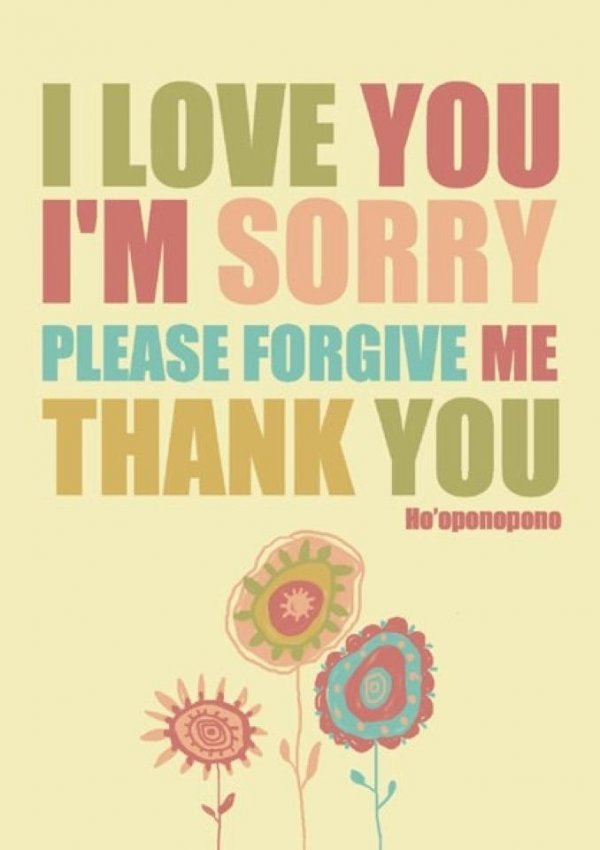Ho'oponopono: How to Take Emotional Responsibility


Written and verified by the psychologist Gema Sánchez Cuevas
Ho’oponopono is an ancient concept for a modern world. It is the Hawaiian art of solving problems by paying attention to their emotional consequences, consequences we usually don’t think about. It involves asking for forgiveness, correcting yourself, changing your ways, and offering kindness. Ultimately, it is a strategy you can employ to get better mental health and learn emotional responsibility.
Ho’oponopono has very deep, centuries-long roots in the Polynesian islands. At first, it had a spiritual meaning; the goal was to connect with the deity. Then, in 1976 this interesting philosophy entered the Western world and opened our eyes.
I love you, and if I awoke hostile feelings within you, I’m sorry, and I ask your forgiveness. Thank you!
Morrnah Nalamaku Simeona, a Hawaiian priestess and healer, adapted traditional ho’oponopono to today’s world. They say she gave a gift to the worlds of personal growth and positive psychology.
Although in the past people practiced it in a group with all the members of their family, today it’s been individualized so that people can practice it whenever they might need it. Ho’oponopono helps you throw off burdens, channel tension, correct your mistakes, and deal with your problems.

“Ho’oponopono”: a practice for better coexistence
The Hawaiians believed that we are all connected to each other through “aka.” Aka is an “ether-like” substance that life’s energy flows through. But sometimes that invisible pathway is weakened by our differences, the problems we pull out of the past, lies, or the words we do and don’t say. Then, the energy stops flowing so harmoniously and that’s when pain, problems, and disorders appear.
However, ho’oponopono helps cleanse your aka. And it doesn’t just heal your relationships with others; it also helps you connect to yourself again. Because if there’s one thing that defines this philosophy, it’s kindness in the broadest possible sense. It’s like an active, all-encompassing act of forgiveness that starts within you and tells you what’s ethical, virtuous, and noble.
Of course this isn’t a scientifically based psychology. Yet even being a spiritual tradition, it is very useful for problem-solving. It has proven effective with problems involving crime and arguments between neighbors, families, and different ethnic groups.

For example, ho’oponopono was implemented in certain prisons and was extremely successful. Elders guided the prisoners through conflict resolution. As a result, there was a kind of emotional catharsis and ultimately improved coexistence in Hawaii’s prisons.
God, clean away everything in me that’s causing this problem to appear. Allow everything perfect and right for everyone involved to be revealed.
How to apply ho’oponopono in your daily life
Ho’oponopono is a code of forgiveness and emotional responsibility. One thing that this philosophy emphasizes is that all conflict comes out of yourself. In other words, you shouldn’t look for external things to blame. We all have the power to change things and turn them into good through kindness, a common spirit, and ethical, emotional consistency.
If you want to apply ho’oponopono to your daily life, follow these strategies.

The 5 steps of ho’oponopono
- First, become aware of your attitudes, emotions, and negative behaviors. These things separate you from the people you love and impact your well-being and personal freedom.
- Next, take responsibility for your actions. Take responsibility for what you do or don’t say, what you do or avoid doing, and what you haven’t tried. Take responsibility for the mistakes you’ve made and all their consequences.
- After that, visualize and feel love. Vividly experience the affection you have for that person or those people you’ve neglected. Open an internal “channel” to them.
- Finally, ask for forgiveness. But careful: in Western culture we usually say “I’m sorry” and think that that’s the end of it. Actually, to properly complete the whole cycle, you also have to receive forgiveness from the other person. To put it another way, you have to hear them say, “I forgive you.”
The last step, just as important, is to experience freedom. The Hawaiians said that when “aka” connects us after the bond has bean cleansed, our souls will be free again. It’s a wonderful feeling. You’ll feel lighter, more whole, and more prepared to start walking again with more self-confidence and wisdom.
Ho’oponopono is a remarkable philosophy. It can give you health and happiness and better relationships. How about putting it into practice?
Bibliographic references:
Pukui, Mary Kawena and Elbert, Samuel H (2009). Hoʻoponopono: Contemporary Uses of a Hawaiian Problem Solving Process University of Hawaii (1986) ISBN 978-0-8248-0703-0
Simeona, Morrnah, Self-Identity through Hoʻoponopono, Basic 1, Pacifica Seminars (1990)
Vitale, Joe, Hew Len Ph.D (2007), Zero Limits. John Wiley & Sons
Ho’oponopono is an ancient concept for a modern world. It is the Hawaiian art of solving problems by paying attention to their emotional consequences, consequences we usually don’t think about. It involves asking for forgiveness, correcting yourself, changing your ways, and offering kindness. Ultimately, it is a strategy you can employ to get better mental health and learn emotional responsibility.
Ho’oponopono has very deep, centuries-long roots in the Polynesian islands. At first, it had a spiritual meaning; the goal was to connect with the deity. Then, in 1976 this interesting philosophy entered the Western world and opened our eyes.
I love you, and if I awoke hostile feelings within you, I’m sorry, and I ask your forgiveness. Thank you!
Morrnah Nalamaku Simeona, a Hawaiian priestess and healer, adapted traditional ho’oponopono to today’s world. They say she gave a gift to the worlds of personal growth and positive psychology.
Although in the past people practiced it in a group with all the members of their family, today it’s been individualized so that people can practice it whenever they might need it. Ho’oponopono helps you throw off burdens, channel tension, correct your mistakes, and deal with your problems.

“Ho’oponopono”: a practice for better coexistence
The Hawaiians believed that we are all connected to each other through “aka.” Aka is an “ether-like” substance that life’s energy flows through. But sometimes that invisible pathway is weakened by our differences, the problems we pull out of the past, lies, or the words we do and don’t say. Then, the energy stops flowing so harmoniously and that’s when pain, problems, and disorders appear.
However, ho’oponopono helps cleanse your aka. And it doesn’t just heal your relationships with others; it also helps you connect to yourself again. Because if there’s one thing that defines this philosophy, it’s kindness in the broadest possible sense. It’s like an active, all-encompassing act of forgiveness that starts within you and tells you what’s ethical, virtuous, and noble.
Of course this isn’t a scientifically based psychology. Yet even being a spiritual tradition, it is very useful for problem-solving. It has proven effective with problems involving crime and arguments between neighbors, families, and different ethnic groups.

For example, ho’oponopono was implemented in certain prisons and was extremely successful. Elders guided the prisoners through conflict resolution. As a result, there was a kind of emotional catharsis and ultimately improved coexistence in Hawaii’s prisons.
God, clean away everything in me that’s causing this problem to appear. Allow everything perfect and right for everyone involved to be revealed.
How to apply ho’oponopono in your daily life
Ho’oponopono is a code of forgiveness and emotional responsibility. One thing that this philosophy emphasizes is that all conflict comes out of yourself. In other words, you shouldn’t look for external things to blame. We all have the power to change things and turn them into good through kindness, a common spirit, and ethical, emotional consistency.
If you want to apply ho’oponopono to your daily life, follow these strategies.

The 5 steps of ho’oponopono
- First, become aware of your attitudes, emotions, and negative behaviors. These things separate you from the people you love and impact your well-being and personal freedom.
- Next, take responsibility for your actions. Take responsibility for what you do or don’t say, what you do or avoid doing, and what you haven’t tried. Take responsibility for the mistakes you’ve made and all their consequences.
- After that, visualize and feel love. Vividly experience the affection you have for that person or those people you’ve neglected. Open an internal “channel” to them.
- Finally, ask for forgiveness. But careful: in Western culture we usually say “I’m sorry” and think that that’s the end of it. Actually, to properly complete the whole cycle, you also have to receive forgiveness from the other person. To put it another way, you have to hear them say, “I forgive you.”
The last step, just as important, is to experience freedom. The Hawaiians said that when “aka” connects us after the bond has bean cleansed, our souls will be free again. It’s a wonderful feeling. You’ll feel lighter, more whole, and more prepared to start walking again with more self-confidence and wisdom.
Ho’oponopono is a remarkable philosophy. It can give you health and happiness and better relationships. How about putting it into practice?
Bibliographic references:
Pukui, Mary Kawena and Elbert, Samuel H (2009). Hoʻoponopono: Contemporary Uses of a Hawaiian Problem Solving Process University of Hawaii (1986) ISBN 978-0-8248-0703-0
Simeona, Morrnah, Self-Identity through Hoʻoponopono, Basic 1, Pacifica Seminars (1990)
Vitale, Joe, Hew Len Ph.D (2007), Zero Limits. John Wiley & Sons
This text is provided for informational purposes only and does not replace consultation with a professional. If in doubt, consult your specialist.







